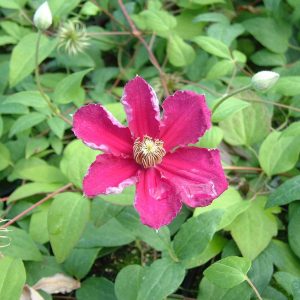Description
Forsythia x intermedia ‘Weekend’ is a deciduous shrub that typically grows to a height of 3.5m and spread of 3m. In early spring, it produces a profusion of bright yellow flowers along its bare stems, making it a popular choice for early season color. The foliage emerges after the blooms have finished, and is a deep green color that creates a beautiful contrast against the bright yellow stems. This shrub is relatively low-maintenance and easy to grow, making it a great choice for beginners or those who want to add a pop of early spring color to their garden without too much effort. It prefers full sun to partial shade and well-drained soil, but is tolerant of a range of conditions. Garden care includes pruning back to a strong pair of buds after flowering to encourage a compact habit and regular watering during dry spells.
Key Facts
- Common Name(s):Forsythia ‘Weekend’
- Hardiness:Fully hardy
- How big will I get? Forsythia x intermedia ‘Weekend’ can grow to a height of 3.5m and a spread of 3m.
- Did You Know That:It is a hybrid of two Forsythia species, Forsythia suspensa and Forsythia viridissima?
Plant Calendar
A rough guide to how this plant will change through the year.
| Jan | Feb | Mar | Apr | May | June | July | Aug | Sept | Oct | Nov | Dec | |
| Flowering Time |  |
 |
 |
|||||||||
| Foliage Colour |  |
 |
 |
 |
 |
 |
 |
 |
 |
| J | F | M | A | M | J | J | A | S | O | N | D |
 |
 |
 |
|||||||||
 |
 |
 |
 |
 |
 |
 |
 |
 |
Care Guide

Soil Requirements
Forsythia x intermedia ‘Weekend’ prefers moist but well-draining soil. This plant can grow in soil with a wide range of pH levels, it is not picky about the pH level of the soil.

Best Position
Forsythia x intermedia ‘Weekend’ can handle either an exposed or a sheltered position and can cope with either full sun or partial shade.

Maintenance
Forsythia x intermedia ‘Weekend’ should be cut back after it finishes flowering will promote growth the following year by redirecting energy from seed production and foliage maintenance to root growth.

Pest, Diseases and Wildlife
Forsythia x intermedia ‘Weekend’ is generally pest free, it can be vulnerable to certain diseases such as honey fungus. It is not considered to be toxic.





